
CHARLES ARDAI is one of those people whose energy, acuity, and achievements make you wonder what the heck you’ve been doing with your life. He’s won the Edgar, Shamus and Ellery Queen Awards, plus he is the author of five novels, including Little Girl Lost and Songs of Innocence. As the founding editor of the acclaimed pulp fiction imprint Hard Case Crime, he has published the works of authors ranging from Stephen King and Michael Crichton to Mickey Spillane, James M. Cain, and Gore Vidal. He also created the Internet service Juno and was one of the writers and producers of the TV series Haven. On Wednesday, September 21, Charles will talk classic mysteries as part of a special MWA-NY panel at the prestigious New York Society Library (details below). We recently sat down at his Manhattan office to talk about that event and about his passion for hard-boiled crime fiction.
Tom Straw: If I were Ernst Stavro Blofeld, I would say, “You confuse me, Mr. Bond.” You graduated from Columbia, summa cum laude, with a degree in English romantic poetry, yet you’re neck deep in pulp fiction. You had an internet startup, but then you went back to the most throwback thing you could do, which is paperback books.
Charles Ardai: I am a man of contradictions.
TS: Explain yourself, sir.
CA: The distinction between the romantics and the hard-boiled writers is not as great as people might think. When Wordsworth and Coleridge wrote lyrical ballads, they were trying to rescue poetry from being something distant from the language of ordinary speakers and write poetry, as they put it, in the language of a man speaking to men. Now how different is this from Raymond Chandler talking about returning violence to the people who commit it for a reason — and not with poison-tipped darts of curare in the vicarage? So I think the impulse is the same, to tell stories ordinary people can relate to. In fact, many of the earliest noir experiences I had, not counting Oedipus, I suppose, and King Lear, came from poems like Browning’s. Now, Browning is generally thought of as a Victorian, but in “Porphyria’s Lover,” about the man who strangles his lover and sits up with the corpse, he is astonished and says, “And all night long we have not stirred, And yet God has not said a word!” So there’s noir to be found, even in old art. But having said all that, the truth is, I just like different things, you know? I grew up reading crime fiction, and I always loved it, and even when I moved onto fancier stuff in college, I never stopped reading it. I like to think that it is not only possible, but healthy, to mix the high and the low, and we try to do that even in our own line.
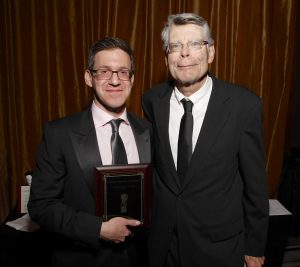
TS: When Stephen King presented you with the Ellery Queen Award, he recalled his youth and spinning the dime magazine rack, which is very visual, very Stephen King. What did you spin on the magazine rack that hooked you?
CA: Oh, gosh. Well, as a kid, the magazine racks were literally wire racks full of comic books. There were magazine racks, but there were no fiction magazines anymore except Ellery Queen and Alfred Hitchcock, and I did grow up reading those. I mostly got old back issues at yard sales. I lived in Manhattan, but my parents would take me up to the Poconos for vacation, and we’d go yard saling, and next to all the ceramic salt shakers and needle point cats were boxes of 25-cent paperbacks and issues of Reader’s Digest and Ellery Queen. I read through hundreds of Ellery Queen issues and fell in love with writers like Stanley Ellin and Jack Ritchie and Donald Westlake and Lawrence Block, who I eventually got to meet and work with, which was a terrific honor. I was born too late to read the pulps — you know, Black Mask and Argosy — but I found them in the Poconos, in cardboard boxes, smelling of mold, and I would read old Erle Stanley Gardner serials as best I could when I had non-consecutive issues from a box. So I fell in love with the literature of an earlier time and wanted to revive it. You asked about the Internet startup . . .
TS: Yes.
CA: I started a company called Juno and ran it for seven years. My head of graphic design there was a guy named Max Phillips, who was also a novelist and a good friend of mine and a brilliant graphic designer. And he also had a childhood reading these old paperback novels with the gorgeous painted covers, and he also was born too late to write them. One night after we arranged the sale of Juno, we sat in the Blue Bar of the Algonquin Hotel, a suitable literary spot, and talked about what to do next, and we both kept coming back to these old books, and, finally, with one too many drinks in me, I said, “Well why don’t we publish a line of books?” At first we thought about reviving Gold Medal, which was the gold standard of paperback publishers in the ’50s, then we realized somebody else already owned the rights. And so we came up with Hard Case Crime. Anyway, if I hadn’t met Max working on Juno, if I hadn’t fallen in love with these books as a child, finding them at yard sales, Hard Case Crime probably wouldn’t have existed.
TS: You’ve also authored five books as well as a number of short stories. Are you a writer who edits or an editor who writes?
CA: I was a writer before I was an editor. I started out as a teenager desperate to make a little bit of money on the side. My brother was a mechanical wizard who could fix hairdryers and would go to all the salons in our neighborhood and charge five dollars a pop to fix theirs. I couldn’t fix anything if my life depended on it, and I sat down, trying to figure out what I could do to earn a buck, and all I could think of was to write. I contacted magazines to see if they would have me. Of course, I was 13 years old, so the answer was no. The New Yorker said no. The Atlantic didn’t bother to respond.
TS: Heartless bastards.
CA: Heartless bastards that they are. But I found, during the first explosion of video games, when the Atari came out in the 1970s, suddenly there were ten magazines on the newsstands covering video games. Pac Man, Donkey Kong, Space Invaders — they needed people to write about these games, and no self-respecting adult who could write for The New Yorker was going to write for them. So I started writing about video games. I wrote a quarter of a million words about video games.
TS: In your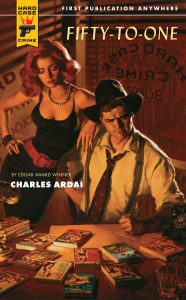 teens?
teens?
CA: Teens and twenties. That’s how I got started. That was before I ever edited anything. But eventually I got a job as an intern at the publisher of Ellery Queen and Alfred Hitchcock and Isaac Asimov Science Fiction Magazine. I was a high school student. I got a free unpaid internship, and at some point the editor of Ellery Queen, Eleanor Sullivan, was putting together an anthology of stories that involved cooking or food. And I overheard and said, “Well, what about ‘Just Desserts’ by Stanley Ellin? There was a soufflé in that.” Th
ey were astonished to discover that this sixteen year old kid had read issues of Ellery Queen dating back to the 1940s and remembered the story. So they would come to me and they’d say, “Mysteries with cats,” and I’d come up with four or five. And that’s how I began editing, and I fell in love with it. But my first taste of editing on the line editing level was from Eleanor Sullivan, when I started writing stories and submitting them to Queen, and she was very nice. She accepted two or three of my stories and then edited them very heavily to show me how to do it right. Or how to do it less wrong. And so that was my introduction to editing: how big a difference her kind attention to my words could make in the quality of my stories. And I like to do that now for other writers. People don’t always appreciate it, but an editor can make a real difference.
TS: Let’s talk about Hard Case Crime. You have a very clear sense of who you are — and aren’t.
CA: True. Hard Case Crime harkens back to the classic pulp paperback crime novels of the 1950s, which were high velocity, short books. They told very concise, typically linear stories. There are, of course, exceptions. You often had a dead body on page one, and if it got to page ten without one, there was something wrong with the book. Either that or a sex scene, or both. You had a plot hook that clicked early for the reader and basically pulled you by the lapels through the book until it deposited you limp and breathless on the last page. The cover art was always painted, and it was always lurid, and the price was the price of an impulse buy — typically the price of a movie ticket. So when movies were a quarter, books were a quarter. And we set out to do the same thing: short, tight, concise, fast, sexy, fun books that you could buy for a throwaway price. And, even when they’re set in the present day, we try to tell the sorts of stories that kept people reading book after book back in the old days.
TS: When you have a form that is so well known, what’s the difference between a submission that’s spot-on versus spit on?
CA: Well put. Sure, if we get another submission that opens with the busty silhouette of a dame through the pebbled glass of a downtrodden detective’s office door while his feet are up on the desk and the whiskey bottle’s in the lower drawer, we will reject it without getting past page one, literally. And we do get those. That’s not the only cliché we see, but we do see it. We get a lot of submissions from people saying, this is like Carl Hiaasen or this is like Elmore Leonard. We get a lot of submissions from people saying it’s about Russian mobsters. And anytime you see a lot of something, it’s very hard for any one example to break out, to stand out as clearly better than the rest. As a rule, anything that is too familiar, too similar, is unlikely to be good. So the goal here isn’t pastiche, and the goal very much isn’t the elbow-in-the-ribs, air quotes, ironic version of noir, where it’s done for a laugh. “Isn’t this old timey stuff cute?” We don’t do that. We’re trying to produce books that are indistinguishable from the real thing, indistinguishable from the old stuff, so it’s not a modern writer’s take on the old stuff. It really should feel like a book that could have been published intact in 1953, even if it’s in a present day setting. And what that means is the emotions are the emotions of classic noir: the despair is real despair; the fear is real fear; the sense of hopelessness of struggling against corruption is real. These are the great things of literature. That’s what makes a book noir. Not the trappings.
TS: The ’50s was a repressed era. And there weren’t a lot of media. Now a reader has seen Dexter. No Country For Old Men. The first season of True Detective. How does that inform your editorial view, and does it pollute the waters for a reader now?
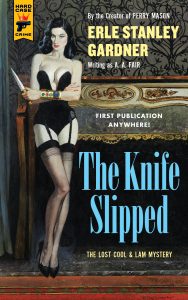 CA: It’s a good question. It’s not so much that it pollutes, but inform is a good word. I think you read any book on the back of the other books you’ve read before it, and so something that would have felt novel and fresh in 1953 might feel unduly familiar today through no fault of the author’s. And so there are books that might have been the first to use a given trope but we can’t reprint now because people will say, as the apocryphal high school student said of Hamlet, “It’s all quotes from lines I’ve heard before.” So we have had to leave a couple of good reprints on the shelf because the plot gimmick or the central situation was just too familiar. But, having said that, there are always new variations. Lawrence Block wrote a book called The Girl With the Deep Blue Eyes for us recently, and the basic outline is the most familiar noir story in the world. Beautiful woman married to an unattractive older man. Has an affair with a tough guy who she seduces to kill her wealthy husband. That’s a very familiar plot. That’s the plot of every James M. Cain novel ever written.
CA: It’s a good question. It’s not so much that it pollutes, but inform is a good word. I think you read any book on the back of the other books you’ve read before it, and so something that would have felt novel and fresh in 1953 might feel unduly familiar today through no fault of the author’s. And so there are books that might have been the first to use a given trope but we can’t reprint now because people will say, as the apocryphal high school student said of Hamlet, “It’s all quotes from lines I’ve heard before.” So we have had to leave a couple of good reprints on the shelf because the plot gimmick or the central situation was just too familiar. But, having said that, there are always new variations. Lawrence Block wrote a book called The Girl With the Deep Blue Eyes for us recently, and the basic outline is the most familiar noir story in the world. Beautiful woman married to an unattractive older man. Has an affair with a tough guy who she seduces to kill her wealthy husband. That’s a very familiar plot. That’s the plot of every James M. Cain novel ever written.
TS: But it’s in the hands of whom?
CA: It’s in the hands of Lawrence Block, who is a brilliant writer and also a brilliant improviser when it comes to plot, and he, like Mozart, can improvise a hundred variations on a single theme. And he came up with a new twist on this one that I didn’t see coming. I was very happy to publish the book because it felt fresh in spite of the familiar premise.
TS: You’ve got a great catalogue. Mickey Spillane, Donald Westlake, James M. Cain, Erle Stanley Gardner, among many, but you also have impressive current authors for Hard Case: you mentioned Lawrence Block. There’s also Stephen King, Harlan Ellison, Ken Bruen —
CA: Yes, together with Jason Starr, collaborating.
TS: I would imagine, given what you do, it’s not too hard to get these people to say, “Yeah, sign me up.”
CA: Authors might love what we do, but whether they decide to play depends in part on how prolific they are. An author who only writes one book every eight or nine years, like Thomas Harris, might love what we do but isn’t likely to devote eight years of his life to producing a book for us. And then the other thing is how deeply entwined is the author with another publisher? Megan Abbott is a fan of our books and a friend, and I’ve wanted for awhile to have a book from her, but the first one (she originally wrote Queenpin with us in mind), Simon and Schuster outbid us for it, as any publisher can outbid us for anything if they try. And she’s been tied up ever since. So there are some authors who I think would enjoy doing something with us, but they have other commitments.
TS: Your titles are arresting. You say that this is not ironic or tongue in cheek, and yet here are a few: Say It With Bullets. So Nude, So Dead. Losers Live Longer. House Dick. Blood on the Mink. And, of course, everybody’s favorite, I’m sure —
CA: The Corpse Wore Pasties?
TS: Exactly right. Are these titles a result of some parlor game?
CA: No. Some of those titles go back many decades. So Nude, So Dead was not the original title, but it was a book by Ed McBain we resurrected. I think the original title was something like The Guilty Sleep, which isn’t bad, but isn’t nearly as exciting. Say It With Bullets and The Corpse Wore Pasties are both comedies, and so you have a little more leeway to title something in a slightly amusing way there. But we favor books that take themselves seriously, tell serious stories, and do very few comedies. But the titles can be fun. It’s a little bit like the naked and half-naked women in the art; it’s what people expect of us, and it’s part of what makes the line fun.
TS: They say don’t judge a book by its cover, but you throw that maxim out the window, don’t you?
CA: Yeah, we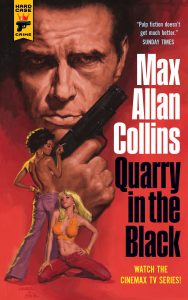 say, by all means, judge a book by its cover. We want to publish books that people are embarrassed to read openly on the subway. That’s our goal. Back in the day you would have two dozen pulp magazines vying for the same dime in someone’s pocket, and they’d try to outdo each other in terms of how lurid and how fascinating their covers were. And we have embraced a similar style with our art. We’ve gone to some old-time painters who are still working, like Robert McGinnis, who’s ninety years old and still paints beautiful colors for us, and some younger painters trained in a similar classical style. And we want covers that make your palms sweat. We want the money to fall right out of them.
say, by all means, judge a book by its cover. We want to publish books that people are embarrassed to read openly on the subway. That’s our goal. Back in the day you would have two dozen pulp magazines vying for the same dime in someone’s pocket, and they’d try to outdo each other in terms of how lurid and how fascinating their covers were. And we have embraced a similar style with our art. We’ve gone to some old-time painters who are still working, like Robert McGinnis, who’s ninety years old and still paints beautiful colors for us, and some younger painters trained in a similar classical style. And we want covers that make your palms sweat. We want the money to fall right out of them.
TS: Talking to you, it’s so clear that you get personal satisfaction out of the whole package.
CA: I do, I do.
TS: And we’re doing our MWA-NY panel a few days from when this blog posts. You, Julia Dahl, Parnell Hall, Joseph Goodrich, and Elizabeth Zelvin will be at the New York Society Library talking classic mysteries. For anyone in that audience who may not be into classics, where will your enthusiasm point them?
CA: Oh, there are writers who, although dead for decades, their work reads as fresh as if it were written yesterday. If you read books we’ve published from the 50s like A Touch of Death by Charles Williams, or Branded Woman by Wade Miller, the cousins who wrote Touch of Evil, which became the Orson Welles movie, those read like a house on fire, and you will not be able to put them down. You won’t go wrong with authors that have survived the test of time. Erle Stanley Gardner, for example, was the best-selling author of his era. There’s a reason so many people read so many millions of his books. They were a lot of fun, and when we discovered a lost Gardner manuscript from 1939 that had never been published, we were thrilled because it’s a chance for people to discover a new book by this old author. Classic novels are one of my great pleasures, and I think people who resist reading something just because it’s old are like people who won’t drink a bottle of wine because it’s old.
TS: What’s new at Hard Case that we should be looking for?
CA: Max Allen Collins, who wrote Road To Perdition, which became the Tom Hanks movie, has a series of novels about a hit man named Quarry. Now he has a TV series coming up on Cinemax about this character, and we’re bringing out a brand new Quarry novel in October, which is timely, not only because the TV series will be going on, but also because it’s set in the weeks leading up to a controversial presidential election. In this case, McGovern-Nixon in 1972. But Quarry, the hit man, is hired to murder a civil rights leader who’s stumping for the democrat, refuses to do it, and investigates to find out who hired him. Turns out to be a racist group from Ferguson, Missouri, of all random places. So if you think there might be some commentary on the modern day in this book, you’re probably right.
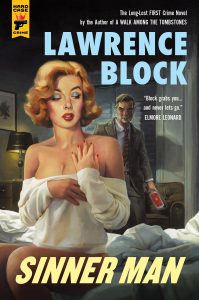 Also, we have a discovery. A lost book by Lawrence Block called Sinner Man, which he wrote around 1960, and lost. It was published under a fake name, under a different title. He didn’t know what name; he didn’t know what title. He didn’t even know what publisher, and spent years looking for it until one of his fans finally found it and recognized it based on the glimmers of recollection Block had about the plot. So we dug up a copy, Larry went back and made revisions, and we’ll be bringing that out as a kind of Christmas treat in November. And then the Erle Stanley Gardner, which is called The Knife Slipped, in December.
Also, we have a discovery. A lost book by Lawrence Block called Sinner Man, which he wrote around 1960, and lost. It was published under a fake name, under a different title. He didn’t know what name; he didn’t know what title. He didn’t even know what publisher, and spent years looking for it until one of his fans finally found it and recognized it based on the glimmers of recollection Block had about the plot. So we dug up a copy, Larry went back and made revisions, and we’ll be bringing that out as a kind of Christmas treat in November. And then the Erle Stanley Gardner, which is called The Knife Slipped, in December.
TS: Last question. You’re boarding a TWA prop plane to a desert island. You’ve got a flask of hooch, a dame, and a dirty secret. What book do you take for the flight?
CA: I’ve got hooch and a dame and I’m gonna be spending my flight reading? [laughs]
INTERVIEWER’S NOTE: Charles Ardai did name his desert-island classic mystery novel. To find out what it is, come to the MWA-NY panel at the New York Society Library, 53 East 79th Street (at Madison), 6-8pm, September 21. This event is free and open to the public, but advance registration is required: Call the NYSL at: 212.288.6900 x230 or go online to events@nysoclib.org. Light refreshments will be served.
—Tom Straw
Tom Straw is an Emmy and Writers Guild of America nominee for his TV writing and producing. He joined the Mystery Writers of America in 2007 on publication of his first book, The Trigger Episode. Subsequently, under a pseudonym, he has authored seven New York Times Bestsellers. He currently serves as a board member of the MWA-NY chapter.
